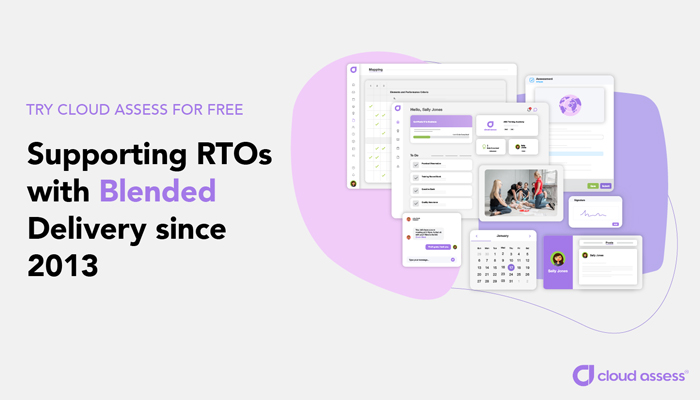Your Cart
Member Lunchbox Webinars
As a Member you get access to over 20 hours of additional recorded webinar content.
VET News
This week in VET
When it Comes to Online Assessment, Are You Really 'In the Know'?
Oct 13, 2022
Skills Ministers Meet to Agree on Strategies for VET Reform
Oct 13, 2022
Drive Your Trainer Excellence to Meet the Needs of an Evolving Future
Oct 13, 2022
VET Regulator News and Updates
Oct 13, 2022
Did You Miss Our Popular TAS Trilogy Series?
Oct 13, 2022
2022 Priority Skills List Reveals Occupations in Demand
Oct 13, 2022
Latest Apprentice and Trainee Numbers Released
Oct 13, 2022
Congratulations to the Winners of the Western Australia Training Awards!
Oct 13, 2022
Skills Service Organisations and Training Package Updates
Oct 13, 2022
Your VET Newsletters, Publications and Media Releases for 13 October 2022
Oct 13, 2022
How to Implement a Successful Blended Delivery Approach
Oct 13, 2022
How to Implement a Successful Blended Delivery Approach

RTOs are embracing blended learning to deliver flexible vocational training and assessment that meets the needs of today’s learners. But there's a problem — implementing blended learning is an art and needs to be adopted strategically. It can be easy to fall into the trap of simply replacing analogue learning tools with digital ones or uploading content in a digital format — without considering how these enhance the learning experience.
Effective blended learning is about leaning into the strengths of in-person training and online learning to create a richer and more collaborative learning experience. So how do you do blended learning right? This article highlights three practical strategies that RTOs can adopt to enable a successful blended delivery approach.
- Adopt accessible and easy-to-use technologies
- Empower facilitators to impart knowledge effectively
- Match teaching methods to clear objectives
Adopt accessible and easy-to-use learning technologies
We can get blindsided by wanting to use the trendiest learning technologies for blended delivery— like Virtual Reality (VR). Unless the training is high risk, it’s unlikely that VR is appropriate or most effective. Complex learning technologies may distract students because they'd spend more time figuring out how these technologies work rather than focusing on the training and completing assessments. Not to mention how costly they can be.
Adopt technology that your students are already familiar with to make learning easier. Cloud Assess is training software designed so that the learner simply logs in and completes their work with clear progression. Kool Kids Training College, Compliance Manager states, “If you can use Facebook, you can use Cloud Assess.” Select a technology that enables learning rather than adds to the pressures.
Empower facilitators to impart knowledge effectively
The success of blended learning lies in how well facilitators understand and deliver it. Technology is moving rapidly and it’s important that providers are constantly adapting and delivering training in the right way, regardless of the available technology.
There are two excellent ways to support trainers and assessors in delivering blended training programmes:
- Immersive training where facilitators experience blended delivery as students, not teachers.
- Regular professional development within this area to continuously learn and improve.
It hasn’t been long since online delivery took the VET sector by storm. Indeed the case for making changes to Certificate IV in Training and Assessment stemmed from the rapid move to online delivery during COVID. There are a number of new skill sets designed to support online delivery. However, getting the blend right will be key to creating great outcomes.
Match teaching methods to clear objectives (and the right technologies)
The main area to get right with blended delivery is using technology with the proper context, to make learning as effective as possible.
There is no point in uploading a 2-hour long video for a learner to watch in isolation. Consider how long people’s attention spans are (typically 10 minutes).
eLearning supports knowledge transfer; however, the VET sector is all about practical learning on-the-job, so a greater mix of tools is required to support learning in a robust way. For example, Cloud Assess supports workplace learning and assessment with tools like coaching events, supervisor records and log books, as well as eLearning.
Developing course content that allows students to participate in active learning rather than passive is key to a successful blended learning experience. If we look at the learning pyramid, for example, only 5% of knowledge is absorbed by passively learning.
 |
A blend of all of these methods is what is most effective, and all of this can be enhanced by technology as the mode rather than the medium. For example, conduct an observation checklist face-to-face using software like Cloud Assess when your learner demonstrates practical knowledge. If you want to introduce some eLearning objects, make sure the learning is broken into chunks and make it as interactive as possible.
Wrapping up
At Cloud Assess, we empower RTOs to deliver blended learning effectively. Through our trusted training and assessment software combined with our industry-leading service, we support our clients on how to effectively use technology to enhance the learner journey and create exceptional outcomes.
Visit cloudassess.co/accredited-training/ to learn more.
Date posted Oct 13, 2022
Contact us
Need some help? Visit our help section to get answers to your questions.
Why join?
Our vision is to educate, inspire, and empower by providing quality, flexible and innovative products and services - the Velg Training membership program is no exception. Packed full of exclusive benefits, our membership program provides access to a range of member-only privileges. Watch now to hear more about these privileges!
Already a member?
Benefit from a free Velg Training profile and receive our fortnightly newsletter
All the great benefits of membership extend to the named individual
Benefits extended to unlimited sibling accounts
+
Account administrator to manage team
+
Track sibling PD history